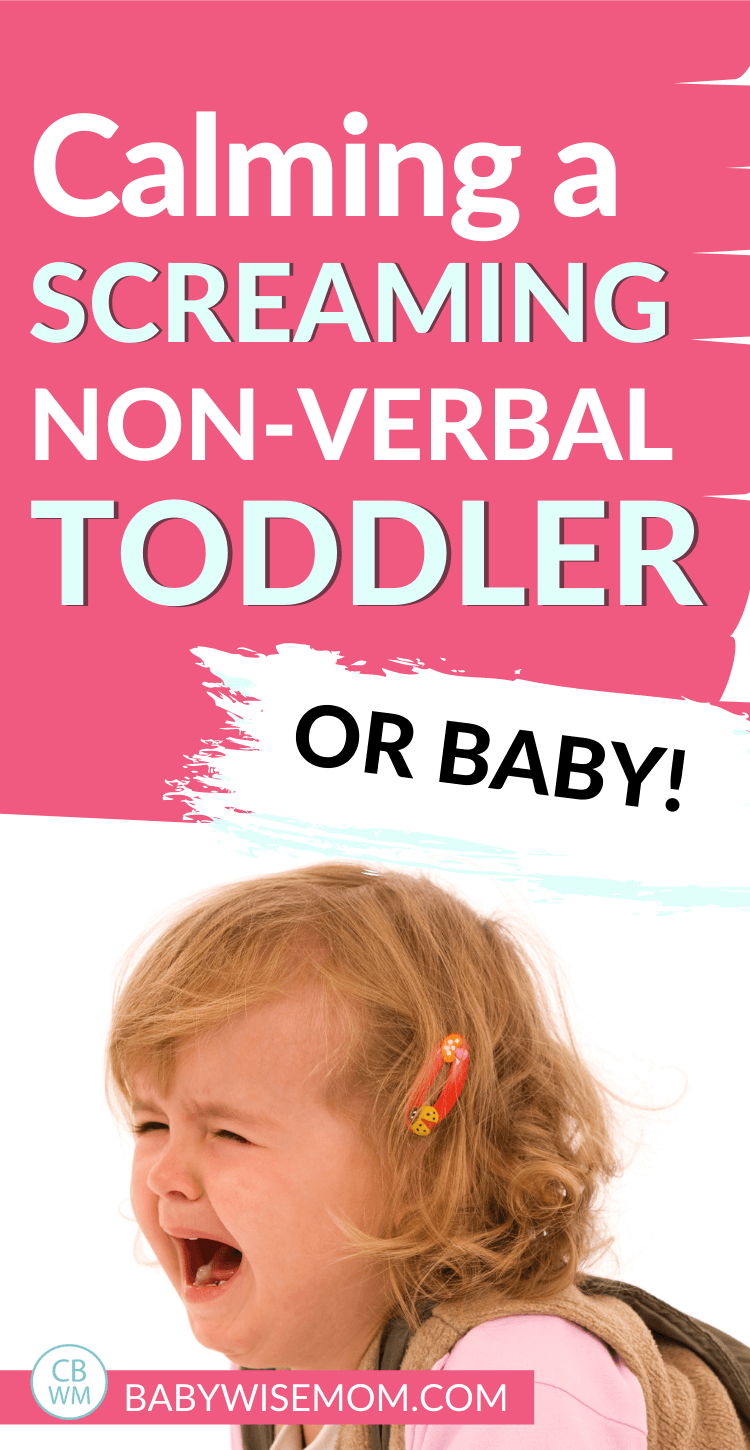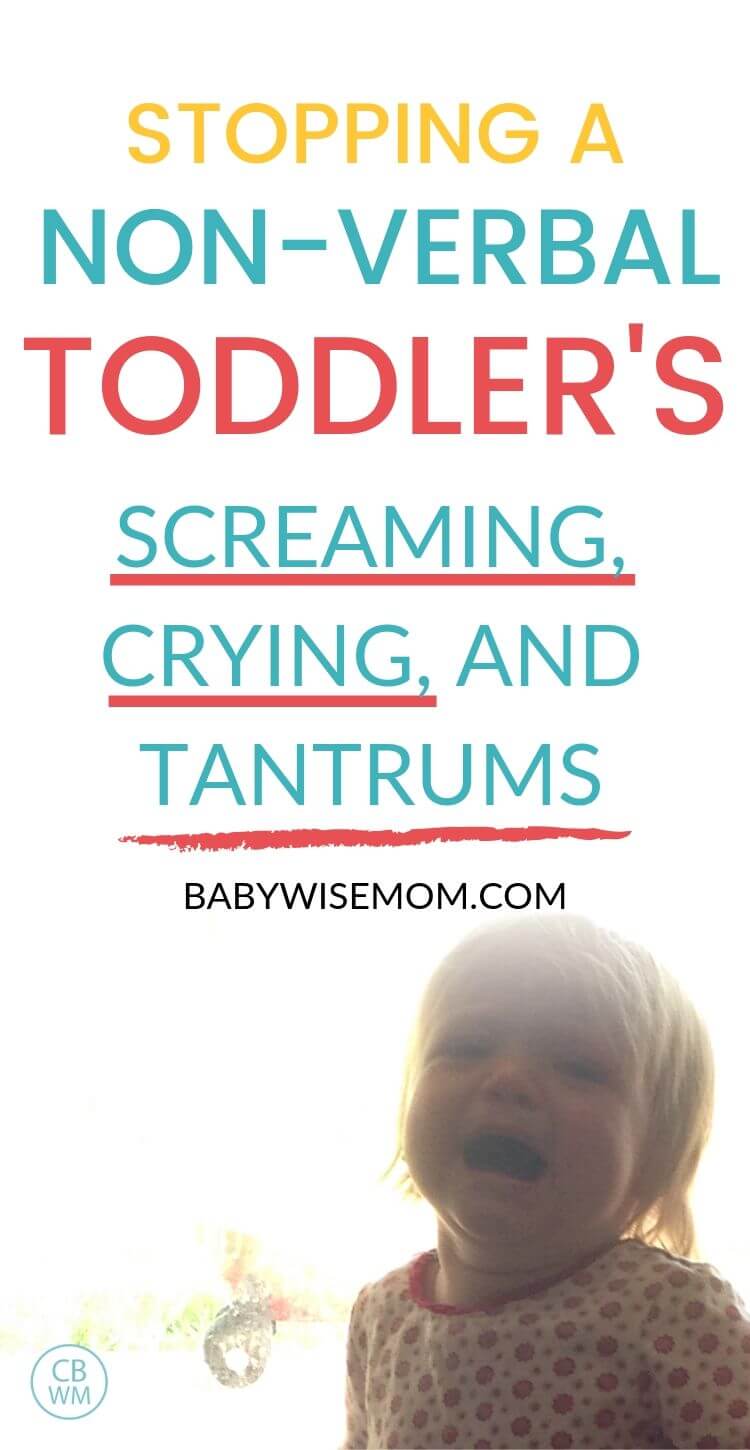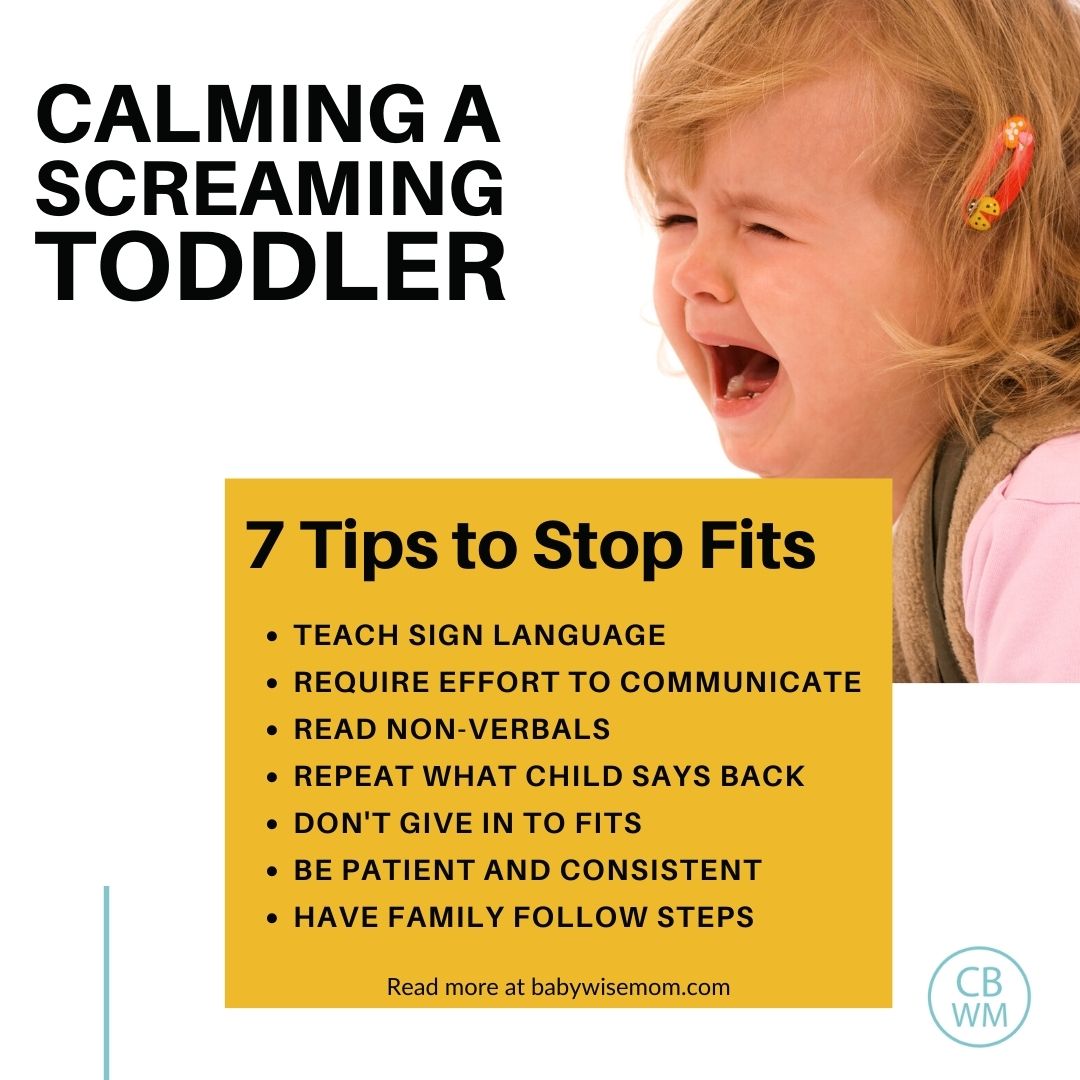Tips for stopping the tantrums, screaming, and crying when you have a non-verbal toddler. Often these tantrums stem from frustration for lack of ability to communicate.

You may be familiar with it. The child who is old enough to know what she wants and certainly has an opinion on what she wants, but she can’t communicate it with you.
The screaming. The crying. The despair. And that’s just you!
Kidding, kidding (sort of).
Of my four children, Kaitlyn was by far and away my easiest pre-toddler (the age range of 12-18 months).
One of Kaitlyn’s big talents in life is communicating. She started signing before 7 months. She started talking around the same time.
By 14 months, she was speaking sentences. She could communicate what she wanted and she knew we understood her, so there weren’t the tantrums that come with communication frustrations.
During Brinley’s pre-toddler months, we had a lot of tears shed over communication issues. Now, I happen to be a really good communicator. I read non-verbals like a pro–and really my minor was in communications and we studied those things closely, so I am not just operating off of instinct.
I have read studies on such things (fascinating, let me tell you). I often find myself interpreting what my friend’s children are trying to tell them–I catch it faster than the mom.
All that to say, even without words, I know what a baby or pre-toddler wants.
But Brinley didn’t seem to have respect for my education or years of experience–news flash child! You are my fourth. This isn’t my first time in the saddle.
She didn’t care.
Any time she asked for something and I didn’t give it to her, she was sure I misunderstood her meaning. Positive.
And she has a flair for dramatic emotions. We are talking hands covering the face while crying, “No!” (those moments when you turn around and walk away so you can laugh without the child noticing).
The older children didn’t help. They loved to inform me of what Brinley wanted. My response was, “I assure you I know what she wants. I know what she wants better than she knows what she wants. I promise I get it.”
And why didn’t that help? Because I had a desperate pre-toddler along with her three desperate bodyguards who seem to think she should never cry.
It also didn’t help because they interfered with her making an effort to communicate on her own. I read about this when Brayden was a baby. Children with many older siblings often speak later because they have several people “speaking for them.”
We happily moved past it with some effort. Brinley came to realize that I understood her and she started putting a lot more effort into communicating.

Post Contents
Tips to Stop Your Toddler’s Screaming, Crying, and Tantrums
I know you are wondering what can you do to help your child move past the fits when she can’t communicate them verbally? Here are some tips.
1-Teach Sign Language
If you have a 14 month old, you might cringe at this tip if you haven’t taught any signs yet. It is never to late to learn signs! I didn’t teach Brayden until he was older than a year (I think it was 13-15 month range).
I always say to teach a sign that is going to reduce fits. So one of the first signs I taught Brayden was “help.”
I have shared this before, but he would want help with something and go into a fit. That wasn’t the way I wanted him communicating help, so I taught him to sign it.
It is best to teach when they aren’t mad and screaming (this is called Training in Times of Non-Conflict). Then when I knew he could do sign it, I would not help him unless he signed for help.
If you have a young baby, start working on showing and helping your baby sign when they are young. I like to teach “more” and “all done” as two of our first signs. It helps immensely with meal times.
2-Require Communication Effort
Do not fulfill the desires of your fit-throwing or screaming child until effort to communicate has been made (effort beyond the fit).
Moms like to say, “Use your words” to fit-throwing children. If your child wants you to pick her up, don’t do it at the first tears. Tell her to ask you to pick her up.
When you first start requiring communication, the communication your child will give you will likely be through tears and anger.
I still remember telling Brayden he needed to say please for something and him slapping his chest in anger in order to sign please.
Another memory is Brinley saying, “buh!” through her tears when she wanted me to pick her up.
I always reward the communication early on, even if the heart is still angry. I want them to recognize that communicating what they want is worth it.
I have hierarchy to this learning process.
I want them to learn that communicating is the way to get what they want, so when they communicate, even if they are angry, I cheerfully respond to the “request.”
Once they get used to the fact that communication is what gets them what they want, then I will start to work on them asking for things with a cheerful heart. I will usually say something like, “Oh, that isn’t how we ask for things. You ask me nicely.”
And RESPOND when your child makes an effort. Don’t say, “just a minute” or ignore your child. You are trying to teach your child to turn to communication first instead of screaming or crying, so reward communication efforts. You need positive reinforcement and you want it to happen quickly.
3-Learn to Read Non-Verbals
Get to know your child. Learn what your child means when she says a word (most words come out quite wrong initially).
Know what she means when she gestures a certain way.
And get to know the pre-fit signs. If you can catch your child before she moves into tantrum mode, you will be more likely to coach her through the communication process without the fit occurring.
This will be great reinforcement for her to communicate rather than have a fit.
4-Repeat What Your Child Has Told You
Make sure you remain calm and firm. You need to be a rock right now.
When your child has communicated something to you, repeat it.
A big fit-session we would have with Brinley was when she would want some sort of treat (the girl has a sweet tooth). She would gesture for it and I would tell her she couldn’t have it right now. She was sure I misunderstood and she would move into upset and frustrated mode that she wasn’t being heard.
Try to get eye-contact and say, “I know that you want a treat right now.” You might even point to the treat to help her further see that yes, you get it. “You may not have a treat right now. Even if you cry about it.” I add in my own non-verbals. I shake my head no.
Once your child knows you get what she is saying, it doesn’t mean she will happily move along thinking, “Oh well. I wanted a treat but mom said no. That is okay.”
Nope.
She will likely cry.
Stand firm!
She is learning what it is like to be told no (and she doesn’t like it). Once she realizes the fits don’t get her anywhere, they will start to go away.
5-Don’t Give In To Fits, Screaming, and Tears
And this leads me to the important factor to not give in to the tears. Don’t say no unless you intend to stick with it.
Once you have said no, stand by it.
This gets trickier as kids get older; their desires are more complicated and you might get more information that can change your opinion on the matter.
I am not talking about that point of life. I am talking about your baby/toddler who is screaming and crying right now instead of communicating.
Your baby and/or toddler has very simple, basic desires. Take 10 seconds to think it through before you answer.
You want to teach your baby that your rules don’t change based on decibel levels or water shed.
6-Give It Time and Consistency
You won’t follow the above five steps and have this screaming solved in a week. Nope. Things are not that fast with children.
It will probably take at least a month, maybe a few, depending on your child’s tenacity and your consistency.
Improvements will be made along the way, but it will take time for your child to move past the fit-throwing.
Have faith! I promise it will work if you stick with the tips above.
7-Get the Family In On It
I find I often needed to sit down with my older kids and really explain what was going on to them. I needed to tell them why she was doing what she was doing and what their reactions did to help/hinder the situation.
I needed to tell them why I responded the way I did. And they understood it once it is explained! (much like an adult being told about their reactions and how it affects their child).
Then they got on board and were supportive of helping to improve the situation instead of being three more hurdles for me to get over.
And this was a unique situation with Brinley–I never had issues when Kaitlyn or McKenna were babies and toddlers. I think my older kids were too young then to try to jump in.
Conclusion
Give the tips a try! You will start to see improvements and you will move toward communication happening and screaming and tantrums diminishing.
Related Posts
- A Simple One-Liner to Stop Whining in its Tracks
- Controlling the Young Temper
- How To Teach Your Baby Sign Language
- How to Deal with Toddler Tantrums
- Teaching Your Baby to Listen to “No”

This post originally appeared on this blog February 2014


Great post! It's exactly what I needed–my 12-month-old screamer is making me ready to scream!
Excellent! Thank you. Just finished leman's books and some of these were touched on. I wish we had started sooner with our son but we're making progress and this was a great reminder for working with our 25mo who barely talks (in words we understand) 🙂 Thanks Val!
I have been reading up on your blog posts related to disciplining, especially at that pre-toddler/toddler age. I posed this question on another (older) post, but thought I would do it here, too, since it's newer and relevant!I have read and understand the idea of figuring out beliefs/goals and the "why" for various behavioral expectations; However, I feel that I am lacking in the "how" department. Do you perhaps have suggestions (or could point me to a blog post) for various discipline strategies (e.g., a toolbox of sorts) that new parents could utilize, since we know that different strategies work with each individual child? Thanks so much if you can help – you are awesome!
how would you handle an 11 month old who is VERY stubborn? My daughter understands signs but she wont sign back. she just cries and cries when I prompt her. I take her hands and make her sign "more" or "all done" and she resists. I have waited her out… but the crying gets worse. whats an appropriate time for waiting? I have waiting a whole 5 min just watching her bang herself around in her high chair. If I just stop feeding her she is fine with this too. its like she doesnt care!! it drives me nuts. I have been signing to her since she was born and still nothing… although I know she knows what Im saying. any ideas?
Also, exactly what I needed tonight.
You’re a great mom. Just wanted to say that.
I have a 10 month old and am so overwhelmed by the task of training him! It’s so hard when he can’t communicate with me yet and I don’t know how to follow through on everything I try to get him to do. And I feel like I’m constantly saying no, and I feel bad about that. But I want to train, not retrain! I was always so confident working with other people’s toddlers, but being a first time mom is definitely more difficult than I thought it would be!! I just finished Babywise Book II this morning and am just reeling with thoughts right now!
desperately I googled “non verbal baby will not stop screeching and screaming” and clicked here. after reading everything, im like 💡this should have been more obvious. my little one is almost 6 months old so I’m sure teething and fighting sleep contribute some of his pitch screaming, but I feel less anxious now that I can apply this and make a plan with him starting with signing.
it has been so exhausting, he screeches when he’s frustrated, happy, immediately after crying, and more often than not at the top of his lungs at high pitch. his older brother was smooth sailing after I found gas drops. I think helping him communicate some needs will calm some of his energy because I realize as I type this he really does not self soothe. crap, gotta google that now!
but thank you! i really feel like this will help so much now and in the coming future.
You are so welcome! I am glad you found what you were looking for.
I’ve been encouraged by your blog for years! I have a nearly 12 month old who screams and screams at meals. How I wish we had started signing earlier, but we have been signing “please” with him at mealtime for a few weeks now with no result. My other children were signing earlier than this one, though I’m sure I had also started earlier with each of them. How long do you think it can take for it to click with our littlest one? I’m sure as in all things in parenting that consistency is the key 🙂 – thank you!
It probably depends on how stubborn he is 🙂 Consistency is key for sure. You being consistent in your requirements and your follow-through. It will come!
Hi! I have a question, my husband will be holding our 14 month old and out of nowhere, with no clues or communication, will set baby down on the ground. This causes a fit ! But I don’t think it’s the baby’s fault . I think my husband should be communicating to our son that “I’m going to put you down on the ground”. I think it is surprising my son that all of the sudden he is being put down. Does that make sense ? Shouldn’t we warn the baby we are going to set him down ?
I don’t think you should have to warn your toddler that you are going to set him on the ground. The motion of moving to set your toddler on the ground should be enough warning. If your toddler is very inflexible, it might help to reduce a fit once set down if you gave a verbal warning. You can certainly try it. But my guess is your toddler simply doesn’t want to be set down and is throwing a fit because of that. You could test with the warning and without and see if a tantrum still follows. If your toddler is indeed in need of a warning to be set on the ground, I would definitely focus on helping him learn to be more flexible with life situations.
I have a 17 month old who screams so loudly and cries the whole time when he sees me getting his plate of food ready or even filling up his cup. Any suggestions on how to handle this? I have tried to withhold the plate/cup and tell him he can have it when he is done screaming but it doesn’t work. Then I start to feel guilty because he is hungry/thirsty. I’d love some help!
The tips in this post will help you a lot with that. You can also see this post for ideas: https://www.babywisemom.com/yellingscreaming_08/